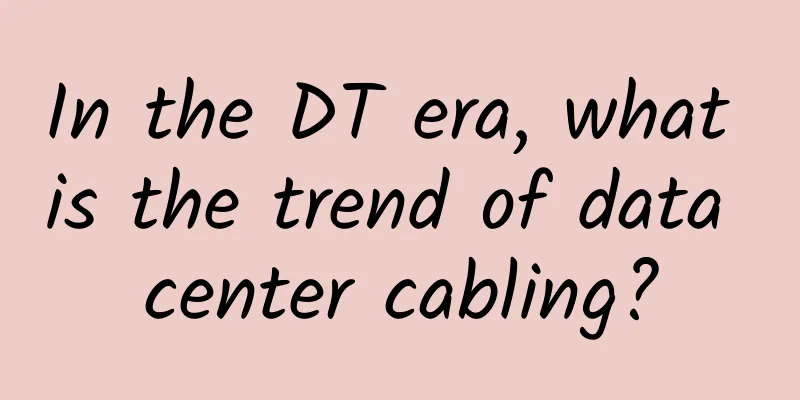In the DT era, what is the trend of data center cabling?

|
As enterprises realize that structured cabling is the foundation of a fast and efficient network infrastructure, managers are rethinking the existing structured cabling design methods and factors. A strong and accurate network infrastructure is essential to adapt to new technologies, support key systems and cost value. Although logical cabling solutions have met the needs of previous networks, they are difficult to meet the requirements of today's physical infrastructure. Enterprises need to plan data center cabling solutions to prepare for optimal configuration, optimal utilization, and higher efficiency. Data center facilities face some challenges in terms of power and cooling, physical space, security risks, and budget.
Today, telecommunications, data transmission and storage, voice and video applications account for most of the market demand, but its back-end functions (such as system updates and monitoring, data backup, software support and ongoing maintenance) are equally important. In addition, according to the forecast of the US market research organization MarketandMarkets, by 2020, the market size of structured cabling will reach 13 billion US dollars. As enterprises move towards cloud data centers with fully virtualized network architectures, data center cabling needs to consider the following five important trends: 1. For modular data center design A significant trend in structured cabling is the transition to new data center construction to support the demand for advanced network functions. As technology develops, organizations are increasingly adopting modular data center cabling solutions. This solution may also support the scalability of data and resources in early planning, reduce overall infrastructure costs, and increase economic benefits in the future. Data center startups will be at the forefront of the industry because they need new technologies and new methods to quickly build new data centers. Specially designed modular data centers are portable and feature unique pre-engineered modules and components that provide scalability. These designs are called containerized data centers or mobile modular data centers. In addition, there are some "drop-in" options available. Whether an enterprise requires a standard or custom modular solution, data cabling infrastructure is the foundation of both. 2. Network infrastructure optimization For those companies that lack technical advantages in data center cabling, although they are ready to upgrade the current data cabling system, the use of services provided by data center providers can quickly integrate network infrastructure. Data center providers are seeking more advanced copper and fiber technologies to meet the needs of existing network infrastructure. Although people's network needs are consistent, for storage, applications, servers and desktops, faster and more streamlined network connections are required. The way to implement it is to optimize data center cabling. Whether IT staff adopts on-premises or cloud solutions, enterprise managers are ready to incorporate data center cabling optimization into the mix. A common approach to optimizing network infrastructure involves standardization of components such as fiber and copper cabling, cabinets, racks, and data center design. This approach, combined with a physical layer cable management system, creates an organized and accessible system that provides valuable data connections at any given time. 3. Seamless cloud computing plan As IT agility requirements grow across the board and enterprises begin to prove that cloud-based alternatives can meet their network needs, managers are looking to design or invest in seamless cloud initiatives. Doing so requires the network cabling industry to provide products that integrate with the most advanced data cabling infrastructure to support these seamless cloud initiatives. Enterprises adopting seamless cloud plans require security, higher transmission speeds, and flexibility. Today, high-end cabling systems are required to meet these high-end demands. Seamless cloud solutions can provide a scalable alternative, with the ability to add (or remove) physical layers in a phased manner for rapid deployment (or reduction). Data center cabling is at the heart of seamless cloud plans. 4. Network integration culture The culture of convergence is not a new concept, but in terms of network and data center cabling, the concept of convergence can be promoted in the data center. Service providers integrate telephone, video and data capabilities through the network to provide attractive services to new markets. In the data center market, cable density can be increased through data cabling to ensure that the network uses the right architecture:
The ability to combine existing digital technologies with a modern network infrastructure that optimizes data center cabling is a culture of convergence that IT leaders are passionate about. Given the speed and scale of technological advancement, this is an ongoing process. 5. Virtualization Services Research shows that more than 50% of small businesses run their workloads on virtual machines, and data center providers have a 95%-100% adoption rate for virtualization services. Virtualization technology continues to prove a scalable, cost-effective network option. There are four common types of virtualization capabilities: server, desktop, network, and storage. Structured data cabling is an important part of network virtualization, and clients can easily create or overlay new virtual networks on existing network topologies. By planning IT services in a virtualized data center, data center cabling can be designed to improve efficiency in various ways from power to capacity. Virtualization also has an impact on cabling. With shared storage, web servers are typically connected to the network using Fibre Channel, iSCSI, SAN or NAS file systems. A stable cabling system is needed in order to operate properly and support many virtual networks for routing and forwarding using simple network cabling links. Given the prevalence of virtualization in modern IT infrastructure, the foundation of structured cabling is a critical component of business operations. Whether it is users moving to cloud data or managed service providers starting to use new B2B, the development trend of data cables shows that technological development is ushering in a new era for high-end data centers. Performance and scalability are important considerations for data center cabling, and a well-designed structured data center cabling infrastructure is a clear way to strengthen the network environment to prepare for change. |
<<: What basic principles should be followed to improve data center operations planning?
>>: 16 real-life digital transformation success stories
Recommend
China Mobile plans to jointly purchase 700MHz base stations with China Radio and Television this year
China Mobile recently released its annual perform...
Have you ever thought about why TCP needs to handshake before sending data?
When I look at computer networks, there is always...
6G Trends in 2023: Architecture drives key technologies from broad to deep
With the large-scale commercial use of 5G network...
HostYun: Unicom AS9929 line, minimum monthly payment starting from 18 yuan, maximum 500Mbps bandwidth, Los Angeles data center
AS9929 line is quite popular recently. China Unic...
Detailed explanation of HTTP protocol security-related headers
HTTP security headers are a fundamental part of w...
5G private network development will accelerate in 2024
The growing demand for fifth-generation network s...
Smart building wiring, how to make a wise choice?
Smart building networks have many extremely speci...
The State Council has deployed to promote the speed increase and fee reduction, and operators have spared no effort on the road to benefit the country and enterprises
In the continuous promotion of network speed-up a...
Huawei launches OceanStor Dorado V6, a new generation of intelligent storage, explaining how data creates value
[51CTO.com original article] Huawei recently rele...
Three major problems facing my country's 5G base stations
At present, the development of 5G commercializati...
Do we really need 5G? Key facts you need to know
First, 2G was used for calling and texting, then,...
Learn about MQTT protocol in one article
Today we will talk about the MQTT protocol in det...
Cisco, the hero behind the scenes who helps turn good thoughts into good deeds
People often have good intentions in their hearts...
How will 5G and edge computing develop in 2020?
At the beginning of the new year of 2020, there w...









